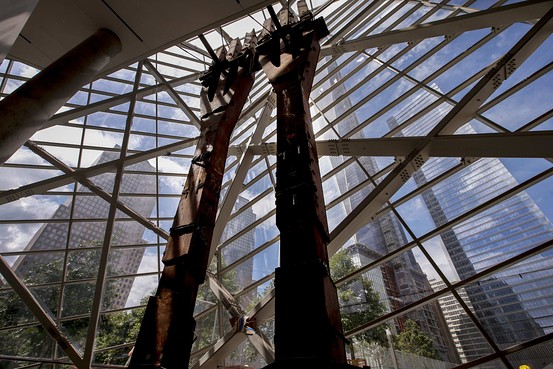By Jennifer Maloney Wall Street Journal

The World Trade Center Cross and a large portion of trident shell are on display inside the new National September 11 Memorial Museum. Kevin Hagen for The Wall Street Journal
After years of delays, the National September 11 Memorial Museum is set to open this spring, but officials still don’t know where they will find the money to keep it running.
The memorial foundation, after failing to secure funding from Congress or New York City, now plans to appeal to the city’s new mayor, Bill de Blasio, to subsidize its projected $60 million annual budget.
In its next overture to City Hall, the memorial will ask Mr. de Blasio to reverse a decision made by former Mayor Michael Bloomberg, who since 2006 has been chairman of the nonprofit memorial foundation. In his capacity as mayor, Mr. Bloomberg decided the city shouldn’t subsidize the memorial’s operations because he felt the terrorist attacks were a national event and the funding therefore should come from Congress, a spokesman said.Marti Adams, a spokeswoman for Mr. de Blasio, said the administration “stands ready to work with the 9/11 Memorial foundation to help ensure that the memorial and museum are state-of-the-art facilities.” But “given the national significance of the memorial,” she said, the mayor believes the federal government “must play a central role” in subsidizing its operating costs.
The memorial covered its $700 million construction cost with a combination of private fundraising and state and federal funds. But the foundation is still looking for ways to cover its operating expenses, which will increase with the opening of the long-delayed museum.
The foundation’s board is considering a museum admission price of between $20 and $25. Victims’ families would be admitted free of charge, and the museum has said it will offer some free hours to the public.
Ticket revenue, along with gift-shop sales and on-site donations, are expected to cover between 60% and 70% of the $60 million needed to operate both the memorial plaza and the museum, foundation spokesman Michael Frazier said.
More than 5 million people visited the 9/11 Memorial plaza in 2013. The foundation expects 2.5 million people to visit the museum each year.
The organization doesn’t have an endowment, and is focused on building one, Mr. Frazier said.
The offices of Sens. Kirsten Gillibrand and Charles Schumer are working on language for a revised funding bill to take to Congress. The foundation is also seeking funds from New York state.
Meanwhile, the foundation this year may have to fall back on a $15 million low-interest line of credit provided personally by Mr. Bloomberg last spring. The foundation didn’t use it in 2013.
In 2011, the memorial asked for $20 million in annual federal funding in a bill sponsored by the late Sen. Daniel Inouye of Hawaii. Republican Sen. Tom Coburn blocked it, saying equivalent cuts should be made elsewhere in the federal budget. In meetings, Mr. Coburn pressed memorial officials on whether the city and state had agreed to subsidize its operations, a spokesman for the senator confirmed. Prompted by those exchanges, memorial President Joe Daniels sent a proposal to a handful of top city officials, according to correspondence obtained by The Wall Street Journal through a public-records request.
The proposal, sent in November 2012, outlined several areas where the city could contribute, from museum exhibitions ($1.8 million a year) to utilities ($7.5 million a year, including $2 million for the pools alone).
The foundation hasn’t released full details of its projected $60 million operating costs, but the proposal reveals a partial breakdown. The city redacted a section of the proposal, citing security reasons. Mr. Frazier declined to comment on whether the memorial had proposed a city subsidy for security costs, which he said would total at least $10 million a year.
Marc La Vorgna, a spokesman for Mr. Bloomberg, said the city had done “more than any municipality ever has to support a memorial for a national tragedy.” City Hall incubated the 9/11 Memorial, helping to bring it into being, and struggled through a stalemate with the Port Authority of New York and New Jersey that delayed the museum’s construction. As chairman of the foundation, Mr. Bloomberg personally donated $15 million and helped woo other donors.
By comparison, the United States Holocaust Memorial Museum, which doesn’t charge admission, received $48.1 million in federal funds for the 2013 fiscal year, covering 60% of its $80.7 million budget.
The Oklahoma City National Memorial & Museum doesn’t receive assistance from any level of government. It charges $12 for admission, and ticket revenue covers a little more than half its $3.6 million budget.
Mr. Frazier said foundation officials are pursuing “avenues to make sure the memorial is here for a very long time”—even if it means asking the new mayor to do something the foundation’s own chairman wouldn’t when he was mayor.
“Why not? Why would they rule that out?” he said. He added that memorial officials are looking forward to meeting with the new mayor and his aides, “and working together to help ensure this important institution is here for future generations.”

